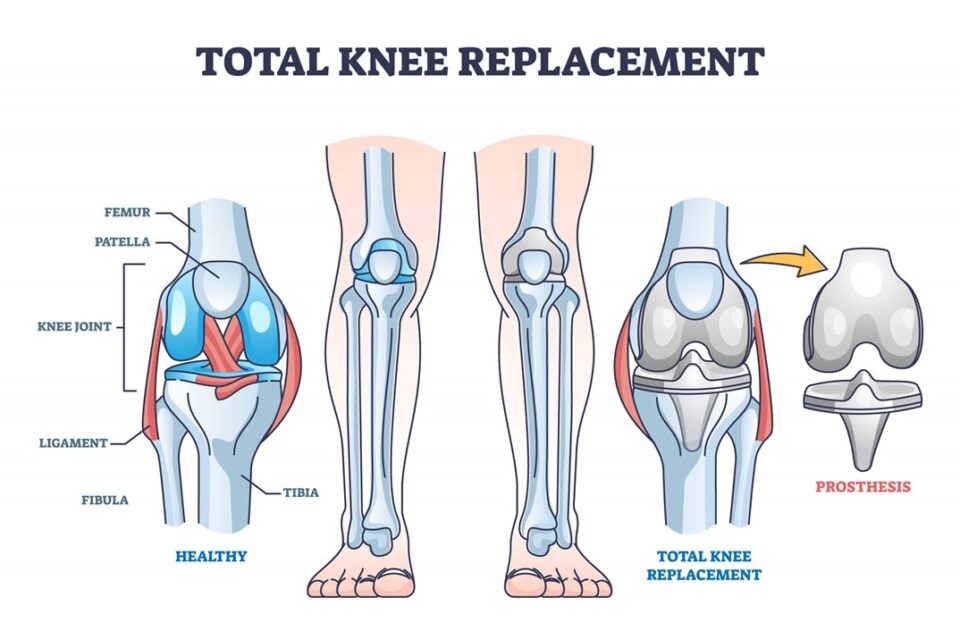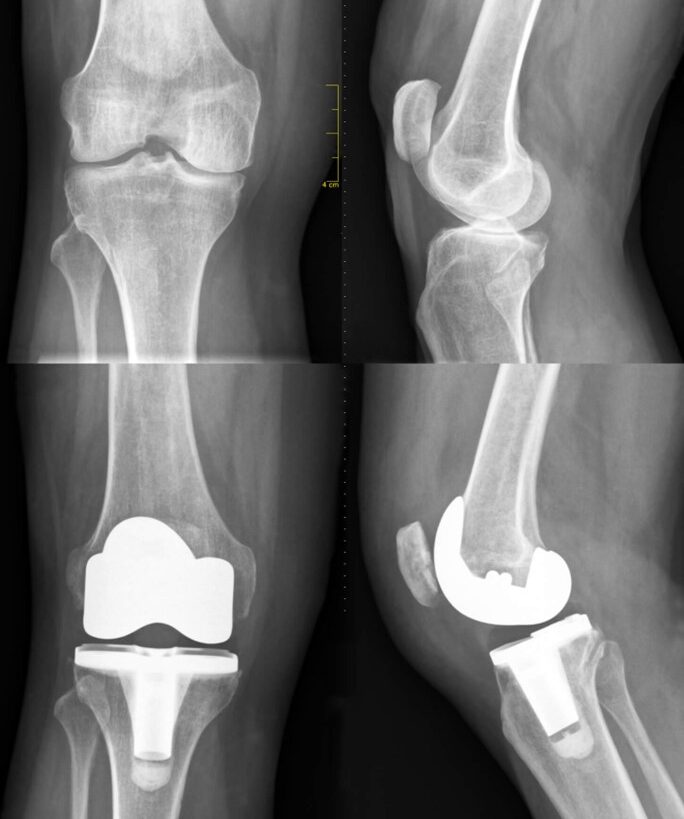Total Knee Replacement Surgery
Total Knee Replacement Surgery
Are you struggling with severe knee pain or stiffness that limits your daily activities? Total knee replacement surgery could be the answer to regaining mobility and quality of life. At the Texas Institute of Orthopedic Surgery & Sports Medicine, we specialize in providing comprehensive care for patients who need relief from debilitating knee issues.

Who is Total Knee Replacement For?
This procedure suits patients suffering from severe knee damage due to arthritis or injuries who have not experienced relief from nonsurgical treatments, such as medications or physical therapy. Total knee replacement is a transformative option that alleviates pain and addresses leg deformities, enhancing overall mobility and quality of life. By replacing the damaged joint surfaces with artificial components, this surgery facilitates smoother movement and significantly reduces discomfort.
Patients can expect to regain the ability to partake in everyday activities, such as walking, climbing stairs, and enjoying recreational pursuits, which may have become difficult or impossible due to knee pain. With advancements in surgical techniques and rehabilitation protocols, many individuals report a substantial improvement in overall functionality and a return to a more active lifestyle post-surgery. This comprehensive approach makes total knee replacement a viable solution for those seeking a long-term resolution to their knee problems.
Benefits of Total Knee Replacement
Anticipate a range of substantial benefits that greatly enhance your overall well-being.
One of the primary reasons individuals choose total knee replacement is to alleviate chronic pain caused by conditions such as osteoarthritis or rheumatoid arthritis. The surgery involves removing damaged cartilage and bone, thus reducing inflammation and discomfort significantly. Many patients report a dramatic decrease in pain levels shortly after surgery, allowing them to engage in activities they once enjoyed without the constant burden of pain.
After recovery from total knee replacement, most patients experience a marked improvement in mobility. The surgery addresses pain and corrects structural issues within the knee joint, leading to better alignment and function. This enhanced mobility often translates into a greater range of motion, enabling individuals to perform movements like bending, squatting, and walking with greater ease and confidence. Many patients can return to activities such as hiking, cycling, or even pickleball, which they may have had to give up due to knee pain.
Pain management and mobility improvements contribute to a significantly enhanced quality of life. Patients often find they can return to daily activities with renewed vigor, whether playing with grandchildren, engaging in community activities, or simply enjoying a leisurely stroll in the park. The ability to perform daily tasks without discomfort boosts physical health and positively affects mental well-being. Many individuals report feeling happier and more fulfilled post-surgery, as they regain the freedom to enjoy life without being hindered by knee pain.
The Procedure Explained
Total knee replacement surgery, or knee arthroplasty, is a comprehensive procedure to alleviate pain and restore function to a severely damaged knee joint. It typically involves the following detailed steps:
1. Prepare the Bone – The first step in the procedure is to prepare the bone. The surgeon begins by making an incision over the knee to access the joint. Once the knee is exposed, they carefully remove any damaged cartilage and a precise amount of bone from the ends of the femur (thigh bone) and tibia (shin bone). This preparation is crucial as it creates a stable surface for the artificial components to be attached securely.
2. Position the Implants – After preparing the bone, the surgeon positions the metal implants. These components, usually made from a combination of cobalt-chromium alloy and titanium, are designed to replicate the natural curvature of the knee joint. The surgeon meticulously aligns and secures these implants to ensure optimal range of motion and stability. In some cases, the surgeon may also utilize a robotic-assisted system to enhance precision during this phase.
3. Resurface the Patella – The patella, or kneecap, is often resurfaced during the procedure to improve joint function and reduce friction. The surgeon removes the damaged cartilage from the underside of the patella and replaces it with a plastic component that matches the shape and size of the original kneecap. This resurfacing is important for smooth movement between the patella and the femur during activities such as walking, running, and climbing stairs.
4. Insert a Spacer – To facilitate smooth gliding between the metal surfaces of the implants, a medical-grade plastic spacer is inserted between them. This spacer, typically made from ultra-high-molecular-weight polyethylene (UHMWPE), acts as a cushion to absorb impact and reduce wear on the artificial components. The thickness of the spacer is carefully chosen based on the individual anatomy and needs of the patient, ensuring proper alignment and function of the knee joint.
5. Final Checks and Closure – Once all implants and spacers are in place, the surgeon thoroughly examines the joint to ensure proper alignment and movement. They will flex and extend the knee to check for any issues. Following this, the incision is closed using sutures or staples, and a dressing is applied.
After the surgery, patients typically undergo a rehabilitation program focusing on physical therapy to regain strength, flexibility, and range of motion. The ultimate goal of total knee replacement surgery is to relieve pain and restore the ability to engage in daily activities with ease and confidence.

Preparing for Surgery
Preparation is key to a successful surgery and recovery:
- Medical Evaluation – Undergo a complete physical examination.
- Preoperative Tests – Blood tests or an electrocardiogram may be required.
- Lifestyle Adjustments – You may need to modify your home for easier navigation during recovery.
What to Expect on Surgery Day
On the day of your surgery, you will be admitted to our state-of-the-art facility in the DFW Metroplex. Our team will ensure you are comfortable and fully informed about every step of the process. After your operation, you’ll be moved to a recovery area where your progress will be carefully monitored.
Recovery and Rehabilitation
Recovery from total knee replacement surgery is a multifaceted process that involves several key stages to ensure optimal healing and regain function. Here’s a detailed look at each aspect of the recovery journey:
Physical therapy starts the day of surgery to promote mobility and prevent stiffness. Patients are typically guided through gentle range-of-motion exercises, focusing on bending and straightening the knee. The early initiation of therapy is critical because it encourages circulation, reduces swelling, and helps manage pain. Physical therapists will provide personalized guidance, ensuring patients perform exercises safely and effectively while considering their pain levels and recovery progress.
As recovery progresses, usually within 3 to 6 weeks post-surgery, patients are encouraged to gradually increase their activity levels. This might include transitioning from using a walker or crutches to walking independently. Low-impact activities such as cycling on a stationary bike or swimming can also be introduced to improve strength and flexibility without putting undue stress on the knee. During this phase, it’s essential to listen to the body and not rush the process; each patient’s timeline may vary based on their health, age, and adherence to rehabilitation protocols.
Ongoing physical therapy is crucial for achieving the best possible recovery outcomes. Patients typically engage in physical therapy sessions several times a week for several months following surgery. During these sessions, therapists will introduce more advanced exercises that focus on strengthening the muscles around the knee, improving balance, and restoring functional movements necessary for daily activities. Continued care may involve consultations with orthopedic surgeons to monitor healing progress through follow-up appointments and imaging if needed. Patients should also be educated about at-home exercises and the importance of maintaining a routine to support long-term knee health.
Potential Risks and Complications
While total knee replacement surgery is highly successful, it is important to be aware of potential risks, which include infection, blood clots, and nerve damage. However, our skilled team takes every precaution to minimize these risks.
Meet Our Team of Specialists
Our team of orthopedic surgeons is renowned for their expertise in knee replacement surgery. With years of experience and a commitment to personalized care, they are equipped to provide the highest standard of treatment.
Contact Us
Schedule a consultation with one of our knee replacement specialists today. Experience advanced knee care with a focus on your recovery and well-being. Choose Texas Institute of Orthopedic Surgery & Sports Medicine, the best choice for knee replacement surgery in the DFW Metroplex.
